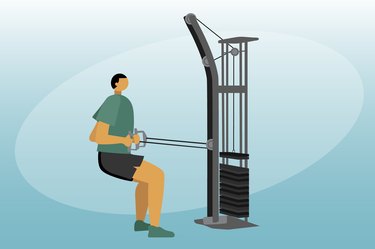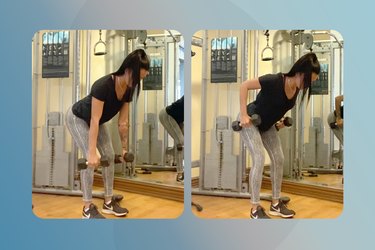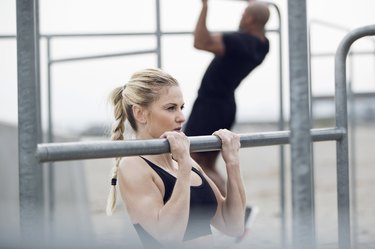

If you usually train your back by pumping out a few sets of bent-over dumbbell rows, it may be time to get up with the standing cable row.
Much like other row variations, the standing cable row works many muscles in your back, including the latissimus dorsi (lats), rear deltoids (one of the three heads of your shoulder muscle), trapezius (traps) and rhomboids.
Video of the Day
"Where the standing cable row separates itself from other variations is the challenge it places on your core and lower body," says Brett Durney, CPT, co-founder and certified personal trainer at Fitness Lab boutique gyms in London. "These muscles will be much more active in the exercise to help you hold your position."
Plus, cable machines come with a lot of attachments. Think: rope, straight-bar, single-handle, v-bar... That means you've got plenty of different grip options, with each one challenging your hands and forearms in new, strength-and muscle-building ways.
How to Do the Standing Cable Row With Perfect Form
Standing Cable Row
- Secure the rope attachment to the cable. Then, grip the rope attachment with both hands and step back until your arms are extended in front of your torso, about chest-height.
- Set your feet shoulder-width apart and bend slightly at the knees.
- Spread the handles wide as you pull the rope into your midsection just below your chest, drawing your shoulder blades together. Keep your elbows close to your sides.
- Pause briefly, and then let your arms extend again. Repeat.
Which Cable Attachment Should You Use?
There are tons of cable attachments you can choose from. The rope attachment shown above is one of the most common options. The biggest benefit to using the rope handle is it activates your wrist and forearm muscles to a greater degree than other attachments, making it a great way to challenge your grip strength, according Jake Harcoff, CSCS, MS, a certified kinesiologist and owner of AIM Athletic in British Columbia. (We’ll cover the other cable attachment options shortly.)
5 Standing Cable Row Benefits
1. It Improves Posture
Most of us could use extra help in the posture department. Sitting for long periods of time — as many of us do — can cause the chest and front of the shoulders to slump forward, sticking the muscles in your upper back in a constantly-lengthened position.
The row helps undo this by shortening the upper back muscles and lengthening the front-body muscles, "effectively pulling your shoulders back and into a more neutral position over time," Harcoff says. Voilà! Better posture.
2. It's Versatile
Cable machines in general are a very versatile piece of equipment. With them, you can change the starting height of any exercise and use a variety of attachments, including a rope, v-handle (also known as a double-D handle), straight-bar and single-handle (also known as a split-handle).
Depending on the starting height and attachment you choose for your standing rows, you can easily tailor this exercise to prioritize different back and arm muscles.
Narrow Grip: "The most commonly used attachments for the standing cable row are the double-D handle and rope, which will [both] give you a narrow grip," says Ariel Belgrave, CPT, a certified personal trainer, health coach, and strength advisor for House of Wise. Both involve a narrow grip that will help build your large back muscles (the lats).
Wide Grip: To spread your hands apart more, use a straight bar or lat pull-down bar. Doing so will put more emphasis on the upper back muscles (rhomboids and trapezius) and arm muscles, she says.
Cable Angle: Starting the row from a lower height will generally engage the lats to a greater extent. But raise the height and you'll recruit more of your upper back and arm muscles.
Grip: Most standing row variations use a neutral or pronated (overhand grip). But, a supinated grip (underhand, palms facing up) grip will work the brachioradialis on the outside of your forearms. According to Harcoff, this tends to be the weakest of your elbow flexor muscles.
3. It Balances Pressing Movements
It's fairly common for people to neglect back exercises in favor pressing exercises that target the chest and shoulders, according to Robert Dodds, CPT, a certified personal trainer and founder of online coaching service Nothing Barred Fitness. This can cause the muscles in the front of your shoulders to become overdeveloped, contributing to that forward slump of poor posture. It can also lead to back and shoulder pain, Dodds says.
Incorporating the standing row can help balance a press-heavy routine, which will only elevate your performance both in and out of the gym.
4. It's Gentle On the Lower Back
Because you don't have to bend over to do this exercise, it's easier on the lower back than most other row variations. Try this exercise if you find bent-over row variations uncomfortable.
5. It Builds Multiple Muscles at Once
The standing cable row targets your rear deltoids, traps, rhomboids, biceps, forearms, core and even legs to some extent, Durney says. So, if you only have a short amount of time to hit as many muscles as you can, this exercise is where it's at.
Why Use a Cable Machine?
Cable machines aren’t better than dumbbells; they simply offer a different challenge for your muscles. The cables maintain a constant force on your muscles at every phase of an exercise, while the pulleys allow you to work at multiple angles, according to the American Council on Exercise (ACE).
4 Tips for Better Results
1. Start With a Split Stance
Durney recommends newbies perform the standing row in a split-stance position: one foot in front of the other, feet hip-width apart.
A split stance offers more stability than standing with your feet parallel (known as a neutral stance), which can help you focus better on the muscles you need to target (lats and upper back muscles), Durney explains.
Once you get the hang of the split-stance standing row, feel free to switch to a neutral stance. It'll work more of your core muscles.
2. Keep Your Legs Bent
To do the row with stable, sturdy form, keep your hips and knees slightly bent at all times. This will help you better brace against the pull of the cable machine. Bonus: It will also build strength and stability in your quads, hamstrings and glutes.
3. Pull Your Shoulders Down and Back
With rows, you want to primarily pull through your upper back and shoulders. But that doesn't mean you should shrug, Durney says. Raising your shoulders takes the emphasis off of your lats and onto your upper traps.
Focus on keeping your shoulders back and down as you row. If you can't — and your shoulders start creeping up near your ears — you may be trying to row too much weight.
4. Keep Your Back Flat
It's important to maintain a neutral spine from head to toe, Durney says. Letting your back round or arch not only lessens the effectiveness of the exercise, but it also stresses your spine. Brace your core and stand tall throughout the exercise.
If you notice your butt start to stick out behind you or your lower back arch, tuck your tailbone. Then squeeze your core to keep it there.
3 Standing Cable Row Variations
Move 1: Standing Single-Arm Cable Row
Training unilaterally (one side at a time) offers unique benefits. Mainly, it helps build strength equally on both sides, as your dominant side can't kick in to help move the weight. This can help even out muscle imbalances.
"Although muscle imbalances are very common and nothing to worry about if they're not too drastic, a significant imbalance can be a predictor of injury," Durney says.
Training unilaterally also offers a greater core challenge by forcing you to resist rotation, he says.
- Secure the single-handle (also known as split-handle) attachment to the cable. Then, grip the handle with one hand (palm in) and step back until your arm is extended in front of your torso, about chest-height.
- Set your feet shoulder-width apart and bend slightly at the knees.
- Keep your hips squared to the cable machine as you pull your elbow to your hip. Squeeze your shoulder blade and end with your elbow pointing behind you.
- Pause briefly, and then let your arm extend again. Repeat until you’ve completed all reps with one arm. Switch sides.
Move 2: Standing Low Cable Row
This variation places more emphasis on the fan-shaped lat muscles that makes up a large portion of your back.
- Secure your attachment of choice to the cable and adjust the height of the cable to the lowest point. Then, grip the handle(s) with both hands (palms in) and step back until your arms are extended.
- Set your feet shoulder-width apart and bend slightly at the knees.
- Pull your elbows toward your hips and draw your shoulders together. Stop when your elbows reach just past your midline.
- Pause briefly, and then let your arms extend again. Repeat for reps.
Move 3: Seated Cable Row
Doing the row seated means your legs no longer have to work to support you. And you won't get as much core engagement, but you'll be better able to focus on your back muscles — a major benefit if your goal is to build strength or size.
- Secure your attachment of choice to the cable and adjust the height of the cable to the lowest point.
- Sit on the floor and grip the handle(s) with both hands.
- Scoot back until your arms are fully extended. Allow your legs to extend as well, or bend your knees and place both feet flat on the floor.
- Sitting tall, pull your elbows to your hips and draw your shoulder blades together. Stop once your elbows reach just past your midline.
- Pause briefly, and then let your arms extend again. Repeat for reps.
3 Standing Cable Row Alternatives
What If I Don't Have Access to a Cable Machine?
If you’re working out at home or your gym doesn’t have a cable machine, duplicate the standing cable row by looping a resistance band around a sturdy staircase banister or securing it to a door anchor. Or, try another row variation like a dumbbell or TRX row.
Move 1: Single-Arm Supported Dumbbell Row
Using the bench or chair for support can help you lift more weight, making it an excellent exercise for building strength. And while the bench takes away some of the balance and stability challenges you'd get from standing exercises, your core muscles still have to work hard to keep your spine neutral, according to Durney.
- Stand facing a bench or chair while holding a dumbbell in your left hand down by your side.
- Keeping your back flat, step your right foot forward and place your right palm flat on the bench or chair. Allow your left knee to bend slightly and your left arm to hang toward the floor, palm facing in.
- Pull the weight toward your ribcage and your elbow back toward your hip, squeezing your shoulder blade at the top of the movement.
- Lower the weight with control until your arm is fully extended. Repeat for reps and switch sides.
- If you need extra support for your lower back, kneel on the chair so your knee is directly under your hip and your supporting hand is directly under your shoulder.
Move 2: Chest-Supported Dumbbell Row
This row variation takes your legs and torso out of the equation entirely, so you can really focus on pulling with your back and biceps.
- Position an adjustable incline bench at 45 degrees and set a pair of dumbbells just beneath it.
- Lie face-down on the bench, so your head clears the top. Your legs should be extended and feet planted on the floor.
- Grip a dumbbell in each hand and let your arms hang straight down, palms facing each other.
- Begin the movement by driving your elbows behind you and drawing your shoulder blades together. Stop when your elbows reach just past your midline.
- Pause briefly, and then slowly lower the dumbbells back to the starting position with control.
- Repeat for reps.
Move 3: Standing Resistance-Band Row
If you don't have access to a cable machine, you can still target many muscles used in the standing cable row with a resistance band.
However, there are some drawbacks to using bands for rowing movements. When you use a band, the resistance increases as you move through the lift. This is great for making an exercise like a squat or upper-body press more challenging, because your muscles are strongest at the top of the movement.
But when performing rows, the opposite happens: The weight gets "heavier" as you reach the top of the movement because your muscles are in a weaker position.
"This can lead to you cheating your [banded] rows, ending with a jerky movement," Durney says. So, be careful not to pick a band that's too thick; you want to be able to complete every row with control.
- Loop a resistance band around a sturdy object like a staircase banister or power rack frame, or attach it to a resistance band door anchor.
- Grip the band with both hands and step back until your arms are extended in front of your torso, about chest-height.
- Set your feet shoulder-width apart and bend slightly at the knees.
- Pull the band into your midsection just below your chest, drawing your shoulder blades together. Keep your elbows close to your sides.
- Pause briefly, and then let your arms extend again. Repeat.
More Standing Cable Row Alternatives
Was this article helpful?
150 Characters Max
0/150
Thank you for sharing!
Thank you for your feedback!


